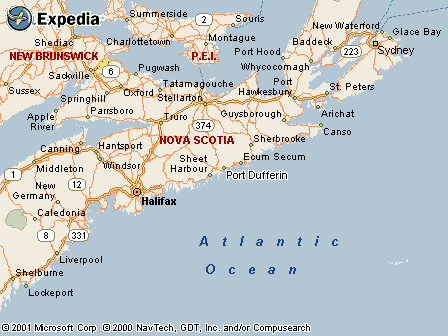 |
|
PORT DUFFERIN TO ST. PETERS NOVA SCOTIA CRUISE - 1 Jim Fraser's Ted Davis Trophy winning log. |
| During my vacation in June, I planned a sailing trip for
twelve days.
I’d cruise and explore along the Eastern Shore of Nova Scotia in my
Wayfarer
dinghy. Close to home with uninhabited islands and dozens of sheltered
estuaries, this is a dinghy cruiser’s paradise. In particular, the
inner
passage stretching front Jeddore Harbour to Barren Island is a fine
cruising
route. Since I wanted time to explore the more distant portions of the
coast though, I launched Naomi 40 miles east of Dartmouth at Port
Dufferin.
Cruising an open dinghy singlehanded and without a motor leaves an
element
of doubt that hampers setting daily schedules for distances covered and
ports to arrive at by the evening.
Canso, an isolated fishing port on the eastern tip of mainland Nova Scotia, was my destination. Eastern Shore coastline is rock bound with extensive shoals and reefs as well as its abundance of islands. Thick fog is common and large ocean swells often generated by storms far out to sea, can make coasting a challenge. Most yachts stand well offshore along this coast on their way to and from the Bras d’Or Lakes. In dinghy cruising, the excitement of exploring the coastal fringe is more important than reaching an arbitrary landfall. Briskly hiking along craggy sea cliffs, quietly lying at isolated anchorages, eagerly examining items found in the tide rack, or idly talking with local residents are more satisfying pastimes than passage making or enduring bland marinas. In this maritime environment, I can escape from the demands of work and home and the frenzied 24/7 lifestyle our society has embraced. Although dinghy cruising alone provides its own set of fears uncertainties and frustrations, the time to myself as well as memories from the passage make it worthwhile. |
 |
| Saturday, June 10
As usual, I found the launching at Port Dufferin chaotic. My normal anxiety was fuelled by a steadily ebbing tide which left Naomi’s hull constantly sticking to the crowns of drying boulders as I loaded my cruising gear. Each time I shifted her, a smear of white gel coat capped the offending rock. At the beginning of each cruise, I promise to take fewer supplies on the next passage - but when the time arrives, I am amazed how much gear I am still trying to stow away. |
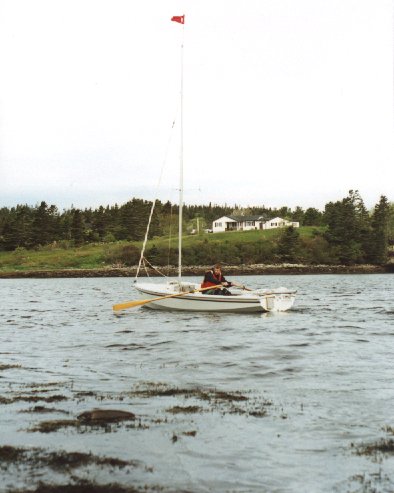 |
|
... |
| I waved Gail a final goodbye, rowed clear of the derelict
wharf, then
hoisted the mainsail and unfurled the jib. Naomi ran before a
chilly
northwest breeze down the harbour, her bow bobbing impatiently towards
the host of intriguing offshore islands. Over her chuckling stern, Port
Dufferin faded, then disappeared, into the gray-shrouded shoreline.
We’re
off! I wonder where we’ll sail and what adventures we’ll have.
With the tiller bungyed to reduce yawing, I stowed and lashed down the anchors, seabags and containers. I dressed in warmer foul weather gear and put on my safety harness and life jacket. I know carelessness can lead to tragedy when sailing alone on this sparsely populated coast with its ice-cold waters. |
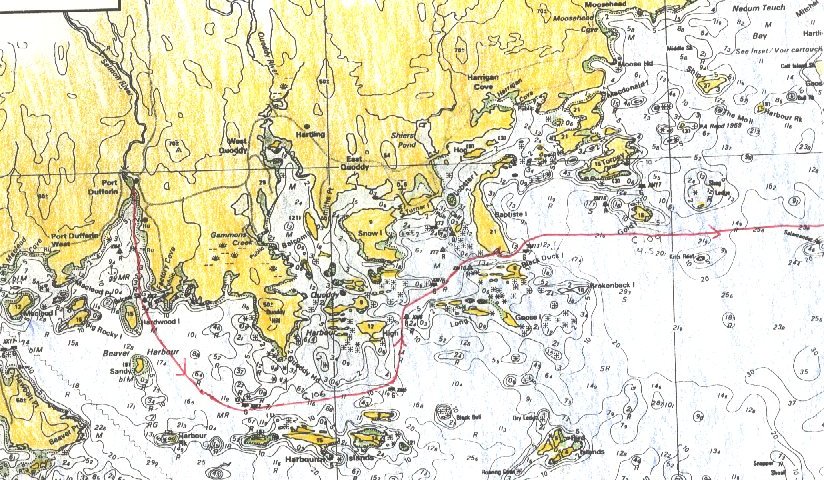 |
| While buoy-hopping between the small obscure green and red
spar buoys,
I realized the compass was reading off, and I had to shift a large
container
stuffed with canned goods from below the thwart further forward to cure
the problem. Before settling down
at the helm, I scanned the sails, sheets, and reef lines to check they weren’t fouled or torn. I finally began to relax. Although I can easily spend a week pottering in Port Dufferin’s waters, I decided to hasten eastward, staying only one right among these islands. Even so, I couldn’t resist stopping at Baptiste Island for a stretch and lunch ashore. Soon the northwest land breeze died, leaving Naomi drifting on a low swell towards rocks off Gold Island. I scandalized the main, and rowed until the southwest breeze arrived. Naomi’s sails filled again on this freshening breeze as she left Halibut Islands to starboard and approached spruce-covered Tuffin Island. The small islands comprising Halibut Islands are nesting grounds for gulls and cormorants. Stunted spruce which endured the harsh environment for decades and grew on thin acidic soil, are quickly killed by bird droppings, leaving only their bleached white trunks and limbs standing. |
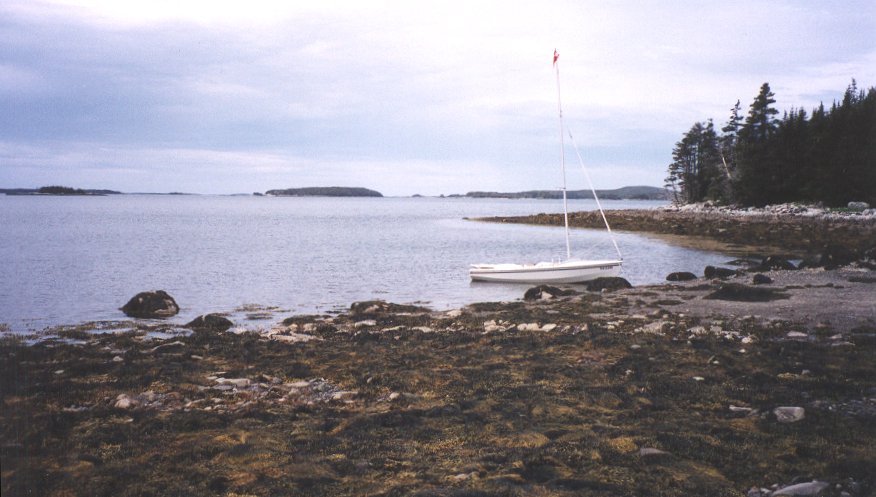 |
|
... |
| I intended to anchor overnight at Barren Island. Although the anchorage can be windy behind the curved gravel arm protecting it, I like to walk the shoreline and rummage through the remains of old wooden fishing boats abandoned there. From Tuffin Island Shoal buoy, my course to this cove was 3 miles directly ahead. Unfortunately the sea was rising and, with soundings at the entrance to Salmoneaux Passage shelving, I might encounter breakers. Instead, I changed course for Cooks and Goose Island which I’d round, and enter Salmoneaux Passage from windward. Both Crooks and Goose Islands’ summits are bleak peat bogs encircled by impenetrable spruce thickets. In spite of their rocky and shallow surroundings, I have spent enjoyable nights at anchor in the minute channels and ponds lying between these islands. |
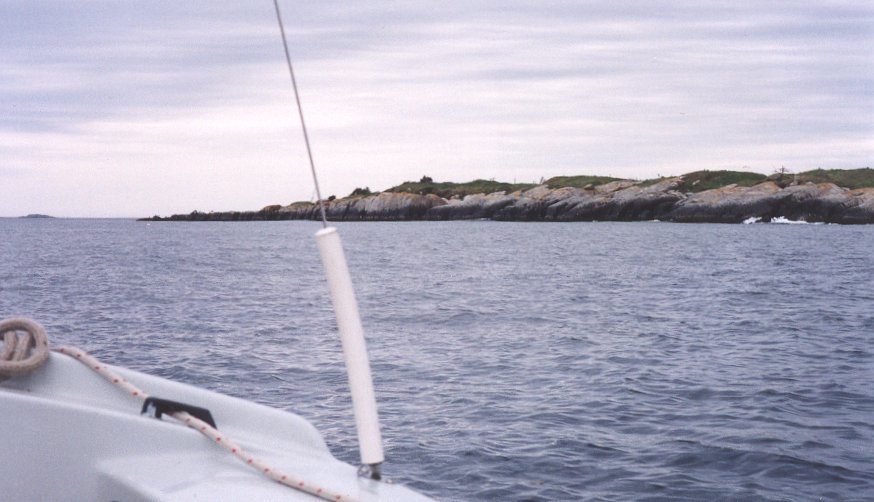 |
|
... |
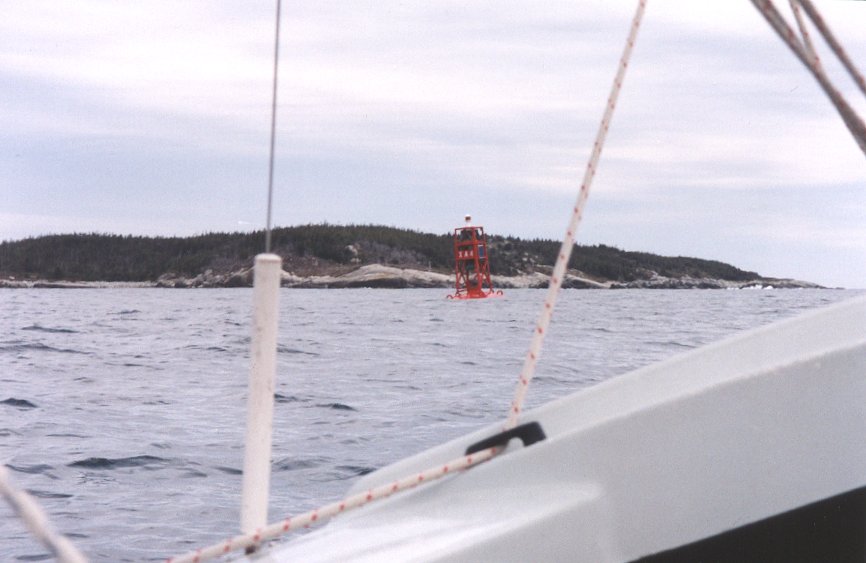 |
|
|
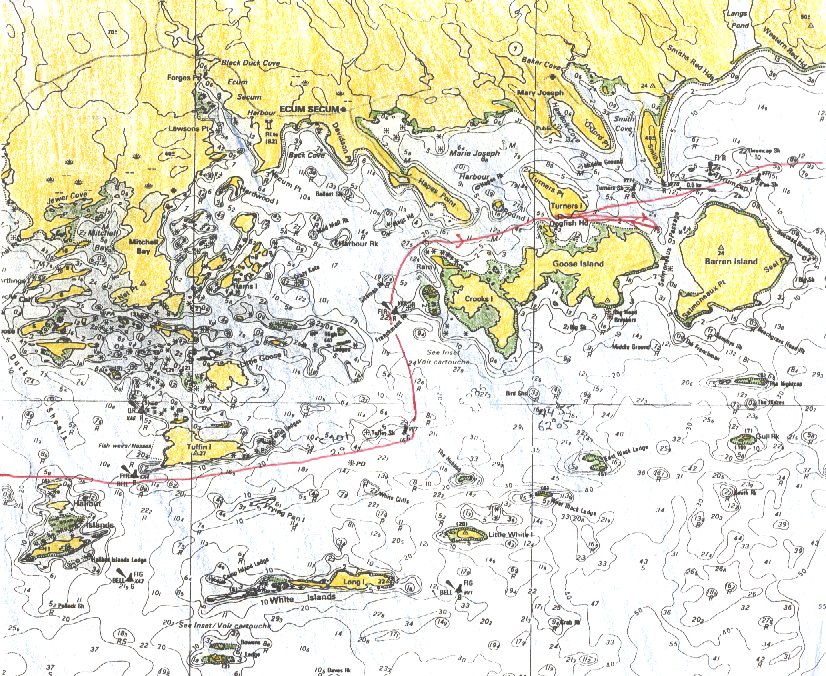 |
| By the time I sailed around Dogfish Head and began to beat up Salmoneaux Passage, a cold gusty force 4 swooped over the islands. I turned back to shelter in a small inlet on Turners Island. Here I moored Naomi with bow and stern anchors under the lee of a dense spruce forest just far enough from shore, that she wouldn’t dry out at low tide. Settlers had attempted to farm this island - but like so many sites along the Eastern Shore, the settlements failed, leaving homesteads to crumble and pasture to overgrow with brush and softwood trees. After ambling through the bush and along the shoreline, I returned to Naomi for supper. Without any interest in elaborate meals, I ate my meal cold - right out of the cans. Then I watched seals surface and dive in the nearby channel before unrolling my sleeping bag for the night. |
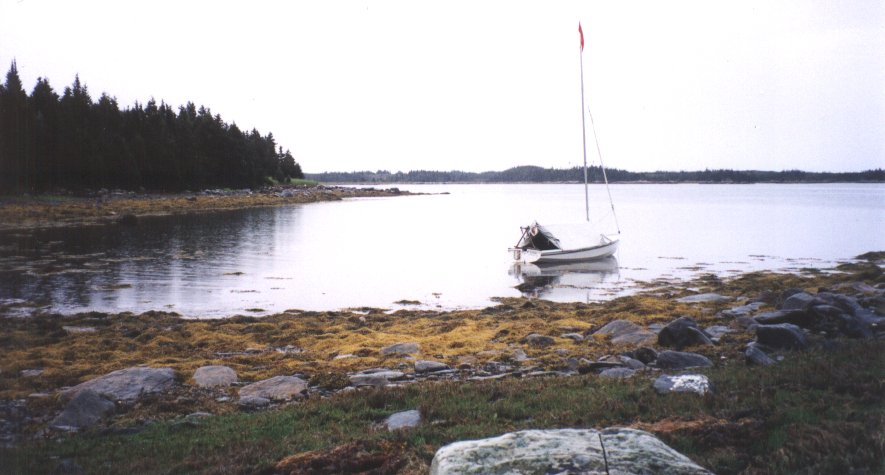 |
|
|
|
|